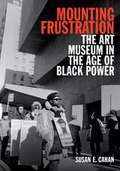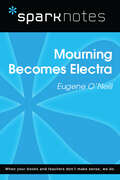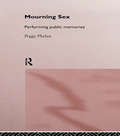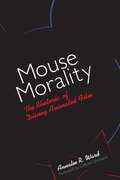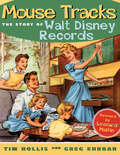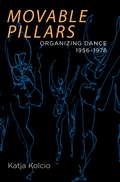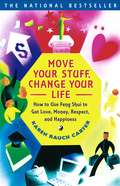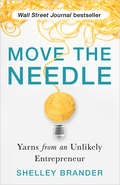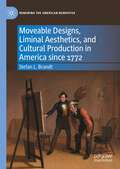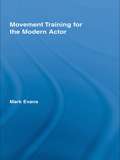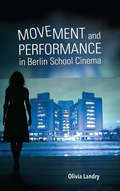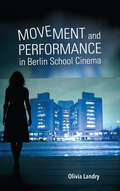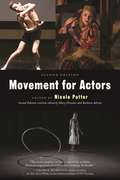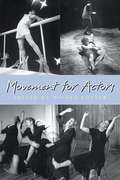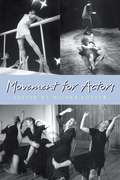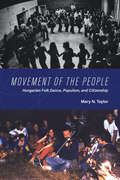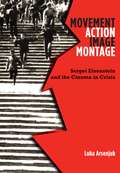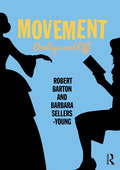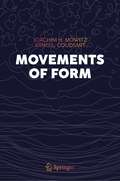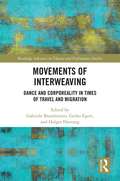- Table View
- List View
Mountain View Trolley Line
by William E. Rogers Jr.The Mountain View Trolley was established on July 10, 1907, after booming tourism increased the need for transportation between Stroudsburg and the town of Delaware Water Gap. In the late 1800s, visitors began flocking to the region to enjoy the beautiful scenery and pristine wildlife. Built by the J. R. Brill Company in Philadelphia, the Mountain View Trolley ran on a narrow-gauge track and was capable of hauling a large number of passengers. The trolley cars operated on overhead wires and battery power and ran year-round, shuttling residents and visitors and working as a school bus for local schoolchildren. The introduction of motor coaches and automobiles brought about the end of the trolley age, and the Mountain View Trolley ended its run in September 1928.
Mountains and Megastructures: Neo-Geologic Landscapes of Human Endeavour
by Christos Kakalis Martin Beattie Matthew Ozga-LawnThis book explores the shared qualities of mountains as naturally-formed landscapes, and of megastructures as manmade landscapes, seeking to unravel how each can be understood as an open system of complex network relationships (human, natural and artificial). By looking at mountains and megastructures in an interchangeable way, the book negotiates the fixed boundaries of natural and artificial worlds, to suggest a more complex relationship between landscape and architecture. It suggests an ecological understanding of the interconnectedness of architecture and landscape, and an entangled network of relations. Urban, colonialist, fictional, rural and historical landscapes are interwoven into this fabric that also involves discontinuities, tensions and conflicts as parts of a system that is never linear, but rather fluid and organic as driven by human endeavor.
Mounting Frustration: The Art Museum in the Age of Black Power
by Susan E. CahanPrior to 1967 fewer than a dozen museum exhibitions had featured the work of African American artists. And by the time the civil rights movement reached the American art museum, it had already crested: the first public demonstrations to integrate museums occurred in late 1968, twenty years after the desegregation of the military and fourteen years after the Brown vs. Board of Education decision. In Mounting Frustration Susan E. Cahan investigates the strategies African American artists and museum professionals employed as they wrangled over access to and the direction of New York City's elite museums. Drawing on numerous interviews with artists and analyses of internal museum documents, Cahan gives a detailed and at times surprising picture of the institutional and social forces that both drove and inhibited racial justice in New York's museums. Cahan focuses on high-profile and wildly contested exhibitions that attempted to integrate African American culture and art into museums, each of which ignited debate, dissension, and protest. The Metropolitan Museum's 1969 exhibition Harlem on My Mind was supposed to represent the neighborhood, but it failed to include the work of the black artists living and working there. While the Whitney's 1971 exhibition Contemporary Black Artists in America featured black artists, it was heavily criticized for being haphazard and not representative. The Whitney show revealed the consequences of museums' failure to hire African American curators, or even white curators who possessed knowledge of black art. Cahan also recounts the long history of the Museum of Modern Art's institutional ambivalence toward contemporary artists of color, which reached its zenith in its 1984 exhibition "Primitivism" in Twentieth Century Art. Representing modern art as a white European and American creation that was influenced by the "primitive" art of people of color, the show only served to further devalue and cordon off African American art. In addressing the racial politics of New York's art world, Cahan shows how aesthetic ideas reflected the underlying structural racism and inequalities that African American artists faced. These inequalities are still felt in America's museums, as many fundamental racial hierarchies remain intact: art by people of color is still often shown in marginal spaces; one-person exhibitions are the preferred method of showing the work of minority artists, as they provide curators a way to avoid engaging with the problems of complicated, interlocking histories; and whiteness is still often viewed as the norm. The ongoing process of integrating museums, Cahan demonstrates, is far broader than overcoming past exclusions.
Mourning Becomes Electra (SparkNotes Literature Guide Series)
by SparkNotesMourning Becomes Electra (SparkNotes Literature Guide) by Eugene O'Neill Making the reading experience fun! Created by Harvard students for students everywhere, SparkNotes is a new breed of study guide: smarter, better, faster. Geared to what today's students need to know, SparkNotes provides: *Chapter-by-chapter analysis *Explanations of key themes, motifs, and symbols *A review quiz and essay topicsLively and accessible, these guides are perfect for late-night studying and writing papers
Mourning Sex: Performing Public Memories
by Peggy PhelanThis is a book about the exhilaration and the catastrophe of embodiment. Analyzing different instances of injured bodies, Peggy Phelan considers what sustained attention to the affective force of trauma might yield for critical theory. Advocating what she calls "performative writing", she creates an extraordinary fusion of critical and creative thinking which erodes the distinction between art and theory, fact and fiction. The bodies she examines here include Christ's, as represented in Caravaggio's painting The Incredulity of St Thomas, Anita Hill's and Clarence Thomas's bodies as they were performed during the Senate hearings, the disinterred body of the Rose Theatre, exemplary bodies reconstructed through psychoanalytic talking cures, and the filmic bodies created by Tom Joslin, Mark Massi, and Peter Friedman in Silverlake Life: The View From Here. This new work by the highly-acclaimed author of Unmarked makes a stunning advance in performance theory in dialogue with psychoanalysis, queer theory, and cultural studies.
Mourning the Nation: Indian Cinema in the Wake of Partition
by Bhaskar SarkarWhat remains of the "national" when the nation unravels at the birth of the independent state? The political truncation of India at the end of British colonial rule in 1947 led to a social cataclysm in which roughly one million people died and ten to twelve million were displaced. Combining film studies, trauma theory, and South Asian cultural history, Bhaskar Sarkar follows the shifting traces of this event in Indian cinema over the next six decades. He argues that Partition remains a wound in the collective psyche of South Asia and that its representation on screen enables forms of historical engagement that are largely opaque to standard historiography. Sarkar tracks the initial reticence to engage with the trauma of 1947 and the subsequent emergence of a strong Partition discourse, revealing both the silence and the eventual "return of the repressed" as strands of one complex process. Connecting the relative silence of the early decades after Partition to a project of postcolonial nation-building and to trauma's disjunctive temporal structure, Sarkar develops an allegorical reading of the silence as a form of mourning. He relates the proliferation of explicit Partition narratives in films made since the mid-1980s to disillusionment with post-independence achievements, and he discusses how current cinematic memorializations of 1947 are influenced by economic liberalization and the rise of a Hindu-chauvinist nationalism. Traversing Hindi and Bengali commercial cinema, art cinema, and television, Sarkar provides a history of Indian cinema that interrogates the national (a central category organizing cinema studies) and participates in a wider process of mourning the modernist promises of the nation form.
Mouse Morality: The Rhetoric of Disney Animated Film
by Annalee R. WardKids around the world love Disney animated films, and many of their parents trust the Disney corporation to provide wholesome, moral entertainment for their children. Yet frequent protests and even boycotts of Disney products and practices reveal a widespread unease with the sometimes mixed and inconsistent moral values espoused in Disney films as the company attempts to appeal to the largest possible audience. In this book, Annalee R. Ward uses a variety of analytical tools based in rhetorical criticism to examine the moral messages taught in five recent Disney animated films--The Lion King, Pocahontas, The Hunchback of Notre Dame, Hercules, and Mulan. Taking the films on their own terms, she uncovers the many mixed messages they purvey: for example, females can be leaders--but male leadership ought to be the norm; stereotyping is wrong--but black means evil; historical truth is valued--but only tell what one can sell, etc. Adding these messages together, Ward raises important questions about the moral ambiguity of Disney's overall worldview and demonstrates the need for parents to be discerning in letting their children learn moral values and life lessons from Disney films.
Mouse Tracks: The Story of Walt Disney Records
by Greg Ehrbar Tim HollisAround the world there are grandparents, parents, and children who can still sing ditties by Tigger or Baloo the Bear or the Seven Dwarves. This staying power and global reach is in large part a testimony to the pizzazz of performers, songwriters, and other creative artists who worked with Walt Disney Records. Mouse Tracks: The Story of Walt Disney Records chronicles for the first time the fifty-year history of the Disney recording companies launched by Walt Disney and Roy Disney in the mid-1950s, when Disneyland Park, Davy Crockett, and the Mickey Mouse Club were taking the world by storm. The book provides a perspective on all-time Disney favorites and features anecdotes, reminiscences, and biographies of the artists who brought Disney magic to audio. Authors Tim Hollis and Greg Ehrbar go behind the scenes at the Walt Disney Studios and discover that in the early days Walt Disney and Roy Disney resisted going into the record business before the success of "The Ballad of Davy Crockett" ignited the in-house label. Along the way, the book traces the recording adventures of such Disney favorites as Mickey Mouse, Donald Duck, Cinderella, Bambi, Jiminy Cricket, Winnie the Pooh, and even Walt Disney himself. Mouse Tracks reveals the struggles, major successes, and occasional misfires. Included are impressions and details of teen-pop princesses Annette Funicello and Hayley Mills, the Mary Poppins phenomenon, a Disney-style "British Invasion," and a low period when sagging sales forced Walt Disney to suggest closing the division down. Complementing each chapter are brief performer biographies, reproductions of album covers and art, and facsimiles of related promotional material. Mouse Tracks is a collector's bonanza of information on this little-analyzed side of the Disney empire. Learn more about the book and the authors at www.mousetracksonline.com.
Movable Pillars: Organizing Dance, 1956–1978
by Katja KolcioMovable Pillars traces the development of dance as scholarly inquiry over the course of the 20th century, and describes the social-political factors that facilitated a surge of interest in dance research in the period following World War II. This surge was reflected in the emergence of six key dance organizations: the American Dance Guild, the Congress on Research in Dance, the American Dance Therapy Association, the American College Dance Festival Association, the Dance Critics Association, and the Society of Dance History Scholars. Kolcio argues that their founding between the years 1956 and 1978 marked a new period of collective action in dance and is directly related to the inclusion of moving bodies in scholarly research and the ways in which dance studies interfaces with other fields such as feminist studies, critical research methods, and emancipatory education. An impeccable work of archival scholarship and interpretive history, Movable Pillars features nineteen interviews with dance luminaries who were intimately involved in the early years of each group. This is the first book to focus on the founding of these professional organizations and constitutes a major contribution to the understanding of the development of dance in American higher education.
Move On: Adventures in the Real World
by Linda EllerbeeEllerbee gives details on how she moved from working with ABC to CNN.
Move Your Stuff, Change Your Life: How to Use Feng Shui to Get Love, Money, Respect and Happiness
by Karen Rauch CarterAn essential and accessible guide to increasing happiness, improving your financial well-being, and bettering your health through the timeless Chinese art of feng shui.Promising health, wealth, and happiness, feng shui offers endless appeal—at least in concept. Unfortunately, feng shui&’s seemingly complicated methods are often difficult to learn and apply in a meaningful way. Fortunately, Move Your Stuff, Change Your Life is written in plain and simple English for the modern Western reader. Revealing the ancient Chinese secrets that are as useful and necessary today as they have been for centuries, Move Your Stuff, Change Your Life communicates how to: · MEET &“THE ONE&” · FIND A DREAM JOB · EARN BETTER GRADES IN SCHOOL · ENJOY A BETTER SEX LIFE
Move the Needle: Yarns from an Unlikely Entrepreneur
by Shelley BranderLearn how to make your big, impossible dreams a reality with help from a creative entrepreneur who's turned her passion into a global force.People always ask Shelley Brander what possessed her to leave the successful advertising firm she founded with her husband to open a local yarn store. And then they wonder how that one storefront grew into an e-commerce business, and from there into a global movement to Knit the World Together. In Move the Needle, Shelley shares stories from her life to show that you can pursue your life's passions--both personal and professional--no matter how quirky or impossible they may seem to everyone around you. Whether you are an entrenched or aspiring entrepreneur, or have a passion that just won't let you go, Shelley shares lessons from her journey that reveal how to: • Put your passion first and make your creative side hustle your main gig • Recognize the true value of creativity and experimentation • Have hope against all odds • Surround yourself with supportive people • Cut ties with those who weigh you down • Believe in the power of your weird, impossible dream!In Move the Needle, Shelley invites you to embrace your passion and hold space for your seemingly improbable (but totally possible) goals, dreams, and purpose.
Moveable Designs, Liminal Aesthetics, and Cultural Production in America since 1772 (Renewing the American Narrative)
by Stefan L. BrandtThe book explores the liminal aesthetics of U.S. cultural and literary practice. Interrogating the notion of a presumptive unity of the American experience, Moveable Designs argues that inner conflict, divisiveness, and contradiction are integral to the nation’s cultural designs, themes, and motifs. The study suggests that U.S. literary and cultural practice is permeated by ‘moveable designs’—flexible, yet constant features of hegemonial practice that constitute an integral element of American national self-fashioning. The naturally pervasive liminality of U.S. cultural production is the key to understanding the resilience of American culture. Moveable Designs looks at artistic expressions across various media types (literature, paintings, film, television), seeking to illuminate critical phases of U.S. American literature and culture—from the revolutionary years to the movements of romanticism, realism, and modernism, up to the postmodern era. It combines a wide array of approaches, from cultural history and social anthropology to phenomenology. Connecting an analysis of literary and cultural texts with approaches from design theory, the book proposes a new way of understanding American culture as design. It is one of the unique characteristics of American culture that it creates—or, rather, designs—potency out of its inner conflicts and apparent disunities. That which we describe as an identifiable ‘American identity’ is actually the product of highly vulnerable, alternating processes of dissolution and self-affirmation.
Moved by Machines: Performance Metaphors and Philosophy of Technology (Routledge Studies in Contemporary Philosophy)
by Mark CoeckelberghGiven the rapid development of new technologies such as smart devices, robots, and artificial intelligence and their impact on the lives of people and on society, it is important and urgent to construct conceptual frameworks that help us to understand and evaluate them. Benefiting from tendencies towards a performative turn in the humanities and social sciences, drawing on thinking about the performing arts, and responding to gaps in contemporary artefact-oriented philosophy of technology, this book moves thinking about technology forward by using performance as a metaphor to understand and evaluate what we do with technology and what technology does with us. Focusing on the themes of knowledge/experience, agency, and power, and discussing some pertinent ethical issues such as deception, the narrative of the book moves through a number of performance practices: dance, theatre, music, stage magic, and (perhaps surprisingly) philosophy. These are used as sources for metaphors to think about technology—in particular contemporary devices and machines—and as interfaces to bring in various theories that are not usually employed in philosophy of technology. The result is a sequence of gestures and movements towards a performance-oriented conceptual framework for a thinking about technology which, liberated from the static, vision-centred, and dualistic metaphors offered by traditional philosophy, can do more justice to the phenomenology of our daily embodied, social, kinetic, temporal, and narrative performances with technology, our technoperformances. This book will appeal to scholars of philosophy of technology and performance studies who are interested in reconceptualizing the roles and impact of modern technology.
Movement Training for the Modern Actor (Routledge Advances in Theatre & Performance Studies)
by Mark EvansThis book is the first critical analysis of the key principles and practices informing the movement training of actors in the modern era. Focusing on the cultural history of modern movement training for actors, Evans traces the development of the ‘neutral’ body as a significant area of practice within drama school training and the relationship between movement pedagogy and the operation of discipline and power in shaping the professional identity of the actor. The volume looks in detail at the influence of the leading figures in movement training — Laban, Alexander, Copeau and Lecoq — on twentieth century professional actor training, and is informed by interviews with students and staff at leading English drama schools. Mark Evans re-evaluates the significance of movement training in the professional drama school, offering a new understanding of the body as a site for performative resistance to industrialization. Despite the publication of a number of ‘how to’ books on movement training for the professional acting student, this is the first text to look behind the curtain and write the unseen biography of the actor’s body.
Movement and Performance in Berlin School Cinema (New Directions in National Cinemas)
by Olivia LandryThrough a study of the contemporary German film movement the Berlin School, Olivia Landry examines how narrative film has responded to our highly digitalized and mediatized age, not with a focus on stasis and realism, but by turning back to movement, spectacle, and performance. She argues that a preoccupation with presence, liveness, and affect—all of which are viewed as critical components of live performance—can be found in many of the films of the Berlin School. Challenging the perception that the Berlin School is a sheer adherent of "slow cinema," Landry closely analyzes the use of movement, dynamism, presence, and speed in a broad selection of films to show how filmmakers such as Christian Petzold, Angela Schanelec, Thomas Arslan, and Christoph Hochhäusler invoke the pulse of the kinesthetic and the tangibly affective. Her analysis draws on an array of film theories from early materialism to body theories, phenomenology, and contemporary affect theories. Arguing that these theories readily and energetically forge a path from film to performance, Landry traces a trajectory between the two through which live experience, presence, spectacle, intersubjectivity, and the body in motion emerge and powerfully intersect. Ultimately, Movement and Performance in Berlin School Cinema expands the methodological and disciplinary boundaries of film studies by offering new ways of articulating and understanding movement in cinema.
Movement and Performance in Berlin School Cinema (New Directions in National Cinemas)
by Olivia Landry“A rich and welcome addition to the surge of scholarly interest in the Berlin School.” —Studies in European CinemaThrough a study of the contemporary German film movement the Berlin School, Olivia Landry examines how narrative film has responded to our highly digitalized and mediatized age, not with a focus on stasis and realism, but by turning back to movement, spectacle, and performance.She argues that a preoccupation with presence, liveness, and affect—all of which are viewed as critical components of live performance—can be found in many of the films of the Berlin School. Challenging the perception that the Berlin School is a sheer adherent of “slow cinema,” Landry closely analyzes the use of movement, dynamism, presence, and speed in a broad selection of films to show how filmmakers such as Christian Petzold, Angela Schanelec, Thomas Arslan, and Christoph Hochhäusler invoke the pulse of the kinesthetic and the tangibly affective. Her analysis draws on an array of film theories from early materialism to body theories, phenomenology, and contemporary affect theories. Arguing that these theories readily and energetically forge a path from film to performance, Landry traces a trajectory between the two through which live experience, presence, spectacle, intersubjectivity, and the body in motion emerge and powerfully intersect. Ultimately, Movement and Performance in Berlin School Cinema expands the methodological and disciplinary boundaries of film studies by offering new ways of articulating and understanding movement in cinema.
Movement for Actors
by Barbara Adrian Nicole Potter Mary FleischerIn this updated rich resource for actors, renowned movement teachers and directors reveal the physical skills needed for the stage and the screen. Readers will gain remarkable insights into the physical skills and techniques used in a wide variety of performance styles through ready-to-use exercises and approaches. Included in this new edition are chapters covering:Stage combatYoga for actorsMartial artsBody-mind centeringAuthentic movementBartenieff fundamentalsGrotowski-based movementThose who want to pursue serious training will be able to consult the appendix for listings of the best teachers and schools in the country. This inspiring collection is a must-read for all actors, directors, and teachers of theater looking for stimulation and new approaches.Allworth Press, an imprint of Skyhorse Publishing, publishes a broad range of books on the visual and performing arts, with emphasis on the business of art. Our titles cover subjects such as graphic design, theater, branding, fine art, photography, interior design, writing, acting, film, how to start careers, business and legal forms, business practices, and more. While we don't aspire to publish a New York Times bestseller or a national bestseller, we are deeply committed to quality books that help creative professionals succeed and thrive. We often publish in areas overlooked by other publishers and welcome the author whose expertise can help our audience of readers.
Movement for Actors
by Nicole PotterTeachers and practitioners offer actors, directors, and students both practical suggestions and inspiration on how to tell the story through the body. Body basics, beyond glove and fan, and schools of thought are among the themes.
Movement for Actors
by Nicole PotterIn this rich resource for American actors, renowned movement teachers and directors reveal the physical skills needed for the stage and screen. Experts in a wide array of disciplines provide remarkable insight into the Alexander technique, the use of psychological gesture, period movement, the work of Rudolph Laban, postmodern choreography, and Suzuki training, to name but a few. Those who want to pursue serious training will be able to consult the appendix for listings of the best teachers and schools in the country. This inspiring collection is a must read for all actors, directors, and teachers of theater looking for stimulation and new approaches.
Movement of the People: Hungarian Folk Dance, Populism, and Citizenship
by Mary N. TaylorSince 1990, thousands of Hungarians have vacationed at summer camps devoted to Hungarian folk dance in the Transylvanian villages of neighboring Romania. This folk tourism and connected everyday practices of folk dance revival take place against the backdrop of an increasingly nationalist political environment in Hungary. In Movement of the People, Mary N. Taylor takes readers inside the folk revival movement known as dancehouse (táncház) that sustains myriad events where folk dance is central and championed by international enthusiasts and UNESCO. Contextualizing táncház in a deeper history of populism and nationalism, Taylor examines the movement's emergence in 1970s socialist institutions, its transformation through the postsocialist period, and its recent recognition by UNESCO as a best practice of heritage preservation. Approaching the populist and popular practices of folk revival as a form of national cultivation, Movement of the People interrogates the everyday practices, relationships, institutional contexts, and ideologies that contribute to the making of Hungary's future, as well as its past.
Movement, Action, Image, Montage: Sergei Eisenstein and the Cinema in Crisis
by Luka ArsenjukA major new study of Sergei Eisenstein delivers fresh, in-depth analyses of the iconic filmmaker&’s body of work What can we still learn from Sergei Eisenstein? Long valorized as the essential filmmaker of the Russian Revolution and celebrated for his indispensable contributions to cinematic technique, Eisenstein&’s relevance to contemporary culture is far from exhausted. In Movement, Action, Image, Montage, Luka Arsenjuk considers the auteur as a filmmaker and a theorist, drawing on philosophers such as Georg Wilhelm Friedrich Hegel and Gilles Deleuze—as well as Eisenstein&’s own untranslated texts—to reframe the way we think about the great director and his legacy.Focusing on Eisenstein&’s unique treatment of the foundational concepts of cinema—movement, action, image, and montage—Arsenjuk invests each aspect of the auteur&’s art with new significance for the twenty-first century. Eisenstein&’s work and thought, he argues, belong as much to the future as the past, and both can offer novel contributions to long-standing cinematic questions and debates.Movement, Action, Image, Montage brings new elements of Eisenstein&’s output into academic consideration, by means ranging from sustained and comprehensive theorization of Eisenstein&’s practice as a graphic artist to purposeful engagement with his recently published, unfinished book Method, still unavailable in English translation. This tour de force offers new and significant insights on Eisenstein&’s oeuvre—the films, the art, and the theory—and is a landmark work on an essential filmmaker.
Movement: Onstage and Off
by Robert Barton Barbara Sellers-YoungMovement: Onstage and Off is the complete guide for actors to the most effective techniques for developing a fully expressive body. It is a comprehensive compilation of established fundamentals, a handbook for movement centered personal growth and a guide to helping actors and teachers make informed decisions for advanced study. This book includes: fundamental healing/conditioning processes essential techniques required for versatile performance specialized skills various training approaches and ways to frame the actor’s movement training. Using imitation exercises to sharpen awareness, accessible language and adaptable material for solo and group work, the authors aim to empower actors of all levels to unleash their extraordinary potential.
Movements of Form (Vision, Illusion and Perception #6)
by Arno L. Goudsmit Joachim H. MowitzThis book offers a thought-provoking exploration of dynamic geometry and its connections to self-reference and theoretical biology. The authors explore how a self-referential boundary can be translated into remarkable relations between expanding geometrical forms, with a particular focus on triangles and circles.The essence of this work lies in revealing not only how these forms expand and interact with others but also how their interactions lead to closed loops of definitions between processes, where triangles and circles reciprocally define one another. These unique geometrical relations offer fresh perspectives on the interaction and emergence of forms. Through the introduction of time and a fixed velocity of expansions, a rich tapestry of encounters and coalescences unfolds, pushing beyond the boundaries of traditional insights on context dependence and state transitions of systems.These captivating movements elude prediction other than by numerical approximation within unpredictable durations. Unlike cellular automata, they defy stepwise progression on a predefined grid, presenting themselves as unprogrammable construction processes that leave readers in awe of their unexpected elegance.This book is essential reading for researchers and students in theoretical biology seeking to deepen their understanding of the intersections of geometry and systems theory and seeking to gain new insights into the processes that underlie the origination of complexity."What is unique to the authors' attempt is to shed a new light on extending the notion of cohesive interaction so as to make it applicable even to biology at large without offending the established physics so far. To the best of my knowledge, their work has been the first attempt of this kind in explicating the intricate relationship between geometric topology of the network and the realizable temporal cohesion to be observed widely in biology." (Professor Koichiro Matsuno, 1st foreword to this book) "I am delighted that the authors use Robert Rosen's (M,R)-systems — impredicative networks that are inherently geometrical — to illustrate (see Chapter 4 of this book) their self-referential systems of geometrical expansions." (dr. Aloisius Louie, 2nd foreword to this book)
Movements of Interweaving: Dance and Corporeality in Times of Travel and Migration (Routledge Advances in Theatre & Performance Studies)
by Gabriele Brandstetter Gerko Egert Holger HartungMovements of Interweaving is a rich collection of essays exploring the concept of interweaving performance cultures in the realms of movement, dance, and corporeality. Focusing on dance performances as well as on scenarios of cultural movements on a global scale, it not only challenges the concept of intercultural dance performances, but through its innovative approach also calls attention to the specific qualities of "interweaving" as a form of movement itself. Divided into four sections, this volume features an international team of scholars together developing a new critical perspective on the cultural practices of movement, travel and migration in and beyond dance.


